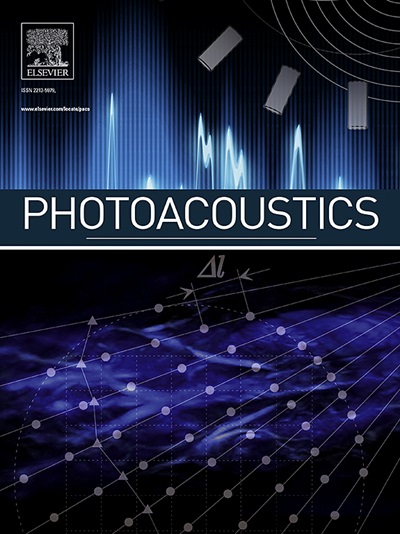Multivariate-coupled-enhanced photoacoustic spectroscopy with Chebyshev rational fractional-order filtering algorithm for trace CH4 detection
IF 7.1
1区 医学
Q1 ENGINEERING, BIOMEDICAL
引用次数: 0
Abstract
An innovative and miniature photoacoustic spectroscopy (PAS) gas sensor based on a multivariate-coupled amplification photoacoustic cell (MVCA-PAC) with a total length of 100 mm was developed to achieve ultra-sensitive trace CH4 detection. Acoustic pressure distribution simulations reveal that at the first-order resonance frequency, the MVCA-PAC achieves a maximum acoustic pressure approximately 3.9 times higher than that of a conventional photoacoustic cell. The absorption optical path of the MVCA-PAC reached 2068 mm through 22 reflections, resulting in a 2-fold increase in the amplitude of photoacoustic signals compared to the traditional photoacoustic cell with an equivalent absorption optical path. Furthermore, compared to a single-pass photoacoustic cell, the 2-f signal intensity of the MVCA-PAC increased by a factor of 4.5. Allan variance analysis indicated a detection limit of 0.572 ppm for CH4 detection with an averaging time of approximately 300 s. To further improve the measurement precision of the designed sensor, the Chebyshev rational fractional-order filtering (CRFOF) algorithm was introduced for PAS signal processing for the first time. Post-processing results demonstrated a 15.4-fold improvement in measurement precision, achieving a precision of 0.578 ppm. Finally, continuous monitoring of atmospheric CH4 over a 48-hour period validated the reliability and feasibility of the sensor.
求助全文
约1分钟内获得全文
求助全文
来源期刊

Photoacoustics
Physics and Astronomy-Atomic and Molecular Physics, and Optics
CiteScore
11.40
自引率
16.50%
发文量
96
审稿时长
53 days
期刊介绍:
The open access Photoacoustics journal (PACS) aims to publish original research and review contributions in the field of photoacoustics-optoacoustics-thermoacoustics. This field utilizes acoustical and ultrasonic phenomena excited by electromagnetic radiation for the detection, visualization, and characterization of various materials and biological tissues, including living organisms.
Recent advancements in laser technologies, ultrasound detection approaches, inverse theory, and fast reconstruction algorithms have greatly supported the rapid progress in this field. The unique contrast provided by molecular absorption in photoacoustic-optoacoustic-thermoacoustic methods has allowed for addressing unmet biological and medical needs such as pre-clinical research, clinical imaging of vasculature, tissue and disease physiology, drug efficacy, surgery guidance, and therapy monitoring.
Applications of this field encompass a wide range of medical imaging and sensing applications, including cancer, vascular diseases, brain neurophysiology, ophthalmology, and diabetes. Moreover, photoacoustics-optoacoustics-thermoacoustics is a multidisciplinary field, with contributions from chemistry and nanotechnology, where novel materials such as biodegradable nanoparticles, organic dyes, targeted agents, theranostic probes, and genetically expressed markers are being actively developed.
These advanced materials have significantly improved the signal-to-noise ratio and tissue contrast in photoacoustic methods.
 求助内容:
求助内容: 应助结果提醒方式:
应助结果提醒方式:


